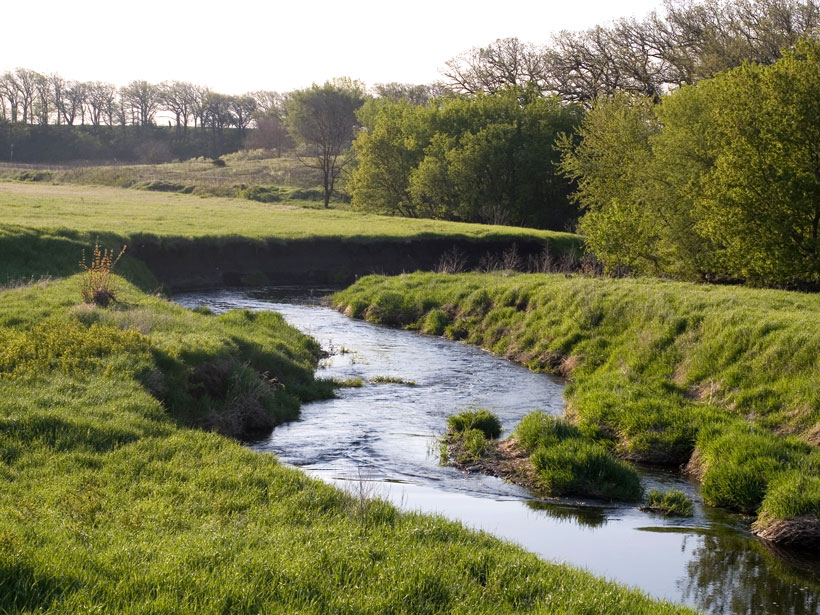Large rivers powerfully sculpt landscapes, but their smaller brethren—streams—are much more numerous and affect local communities and ecosystems. Now, scientists have used multidecadal data sets to trace how streamflow across the continental United States has changed in response to urbanization. They found a variety of trends, complicating the long-standing notion that city growth has a consistent impact on nearby waterways.
Decades of Streamflow
Aditi Bhaskar, a hydrologist at Colorado State University in Fort Collins, and her colleagues started by mining a U.S. Geological Survey (USGS) data set of streamflow measurements. The data set, which included measurements across the United States from more than 9,300 streamgages, stretches back decades. “That’s our best national-scale measurement of streamflow,” said Bhaskar.
“We wanted to look at watersheds while they’re being urbanized.”
Bhaskar and her collaborators combined these streamflow data with records of housing density and impervious (e.g., concrete, asphalt) surface cover. They honed in on gages that had at least an uninterrupted 20‐year streamflow record and whose watersheds—ranging in size from 5 to 162 square kilometers—were undammed and also satisfied certain criteria related to size, impervious surface cover, and housing density.
“We wanted to look at watersheds while they’re being urbanized,” said Bhaskar.
The researchers whittled down their sample to 53 gages across the continental United States in areas such as Indianapolis, Ind.; Colorado Springs, Colo.; and Austin, Texas. The spatial coverage of the final sample is probably biased, Bhaskar and her colleagues note. “Streamgages are largely put on perennial rivers, rivers that flow all year-round,” said Bhaskar. “Our analysis is, of course, biased in the same way that the USGS streamgage network is biased.”
Zooming In on City Growth
Bhaskar and her colleagues then matched each watershed with a similarly sized watershed that had experienced only minimal urbanization. That allowed the team to subtract out climate-induced changes in streamflow and isolate just the changes associated with city growth.
“Urban hydrology was oversimplified from the start.”
The scientists found mixed results: Higher streamflows tended to exhibit increasing flows as areas urbanized, but lower streamflows experienced both increases and decreases in flow. “It was pretty evenly split between watersheds where low flows increased with urbanization and other watersheds where low flows decreased with urbanization,” said Bhaskar. “We don’t see consistency.”
That’s an important finding, said Sarah H. Ledford, a hydrologist at Georgia State University in Atlanta not involved in the research. It counters the assumption that streams everywhere exhibit a homogeneous response to urbanization. “Urban hydrology was oversimplified from the start,” said Ledford.
Draw and Release
It makes sense that streamflow would vary as a city grows, said Bhaskar, because urban areas both draw and release water. “Upstream of the city, there’s the withdrawal for the water supply. A little bit downstream, but upstream of the next city, is the wastewater effluent release.”
Cities, with their impervious surfaces, also look different than nonurbanized areas. These surfaces prevent rainfall from infiltrating into the ground, so storm runoff, which is often routed directly to streams, can lead to increasingly high flows, said Bhaskar.
These results were published earlier this year in Water Resources Research.
Bhaskar and her colleagues are currently investigating a few individual watersheds in greater detail. The goal, she said, is to get a more nuanced look than what’s possible with a national-scale study. In Maryland, the team is analyzing how the presence of green infrastructures—such as infiltration trenches and tree boxes—affects changes in streamflow. And in Colorado, they’re looking at streamflow changes that result from a practice common in urban areas: watering one’s lawn.
—Katherine Kornei (@KatherineKornei), Science Writer
18 December 2020: This article has been updated to clarify the mixed results of the study.
Citation:
Kornei, K. (2020), Waterways change as cities grow nearby, Eos, 101, https://doi.org/10.1029/2020EO152751. Published on 17 December 2020.
Text © 2020. The authors. CC BY-NC-ND 3.0
Except where otherwise noted, images are subject to copyright. Any reuse without express permission from the copyright owner is prohibited.

